
13
Initial Startup
The first time that the still is started, or after
cleaning, operate the still as follows:
1.
Close the drain valve.
2.
Open the deconcentrator valve slightly.
3.
Open the cooling water inlet valve.
4.
Open the cooling water throttling valve
about 1/2 turn.
5.
When water begins to issue steadily
from the deconcentrator valve, turn on
the still heat supply.
6.
When the still begins to produce distilled
water, close the deconcentrator valve
and adjust the cooling water throttling
valve until a puff of steam issues from
the condenser vent. Discard the first two
hours production of distillate to allow the
still to clean itself out.
7.
Adjust the deconcentrator as described
below.
Initial Operation
The first time the still is operated, or after
cleaning, set the low water cutoff control
“ON/OFF” toggle switch to ON position, open the
manual drain valve and operate the still accord-
ing to the basic still operating instructions. The
lighted switch will remain lit as long as the switch
is in the ON position. The “Still On” lamp will light
when the water in the evaporator makes contact
with the probe. The still is started and stopped
with the “ON/OFF” toggle switch.
Operation
Warning
A fire hazard may result if the
still is used with a flammable liq-
uid. “Caution: Hot Surface. Avoid
Contact.”
Note
During the procedures listed
below, check all connections for
leaks and tighten as required.
Note
The cooling water inlet and
throttling valves are shown in
dotted lines. If these were not
purchased with the still, they
must be installed in the cooling
water inlet line by the customer
to ensure proper operation.
Caution
Ensure that the water level in
the evaporator is above the
heating elements before turning
on the still. The heaters are the
immersion type and will burn out
if operated in air. The water level
should be safe when water
issues steadily from the decon-
centrator valve.
Note
Ideally, the temperature of the
steam and gases escaping the
vent should be 70°C or higher.
To measure the vent
temperature, use a
thermocouple probe, such as
the Thermolyne PM20700
Digital Pyrometer, inserted into
the vent.














































